Framing the Concepts in Specialized Texts: a Cognitive Approach to Terms in Qantas 32 Investigation Report and Their Translations
摘要
术语在现代科技体系中占据着越来越重要的地位,而译者的术语能力也是一项基本素质要求。过去十年,术语学正经历认知方向的转变。法贝尔(2005)以认知语言学为基础提出框架术语学,强调“概念网”的建立。英语是国际民航的通用语言。随着全球民航业的发展,培养非英语母语译者的民航术语能力至关重要。通过节选澳航32号航班事故调查报告进行汉译,依托框架型术语学,从概念网建立、术语单元组合、图像确认三方面,结合实例探讨其对专门用语翻译的指导意义以及对译者术语能力培养的影响。
关键词
民航术语;术语翻译;框架术语学;术语能力
Abstract
Italiano | IngleseLa terminologia svolge un ruolo centrale nella scienza e tecnologia del mondo contemporaneo. Analogamente, la competenza terminologica è un requisito essenziale per tutti i traduttori professionisti. Sfruttando un approccio legato alla linguistica cognitiva, FABER, MÁRQUEZ & VEGA (2005) hanno sviluppato un modello terminologico basato sul concetto di frame nel quale è centrale la determinazione di una rete concettuale. L'inglese è di fatto la lingua dell'aviazione civile internazionale e dunque i parlanti non madrelingua sono posti di fronte alla sfida di migliorare le proprie competenze terminologiche per tradurre in questo specifico settore. Nel contributo proponiamo uno studio di caso relativo alla traduzione di 10 sezioni del Qantas Flight 32 Occurrence Investigation Report dall'inglese al cinese. Sulla base del modello di FABER, MÁRQUEZ & VEGA, esploriamo i tre elementi che contribuiscono alla costruzione della competenza terminologica: la costruzione di una rete concettuale, l'ubicazione delle unità terminologiche all'interno di essa e la verifica per immagini.
1. Introduction
One of the major concerns for Terminology lies in the description of concepts. In the past two decades, the cognitive aspect of lexical units and their impact have gained more attention. Similarly to Linguistics, Terminology has also been affected by the cognitive shift, which has led both disciplines to focus increasingly on the conceptual network underlying language (FABER 2012: 286). It is not an accident that such theories have gradually merged with Translation Studies.
Officially mandated by the International Civil Aviation Organization (ICAO), English is «the de facto language for international civil aviation» (ALDERSON 2011: 387). As a comprehensive but specialized subset of English, aviation English includes “plain” language used for radiotelephony communications when phraseologies do not suffice. Not restricted to controller and pilot communications, aviation English also includes the use of English for various aspects of aviation. For example, the language used by maintenance technicians, dispatchers, or managers and officials within the industry.
To provide language services for this domain, translators should be fully aware of the terminological units and the specialized knowledge representation. For instance, the common word "taxi" can become a term in an airport environment, denoting the movement of an aircraft on the ground at very low speed. According to regulations of radiotelephony communication, H is pronounced as hotel [həʊˈtel] for clarity. In this sense, “taxi to hotel” should be translated into “滑行至H点” (slowly move to H point) instead of “打的去旅馆” (taking a cab to the hotel). Therefore, terminological competence is essential for civil aviation English translators to ensure accuracy and proficiency in their jobs.
Air travel in China was once only for the privileged few; it is currently one of the most important markets within the aviation industry. A 2018 government report stated that a total of 46 airports would be developed within the following five years. New intercontinental routes opened by Chinese carriers in 2006 increased the amount only by six units, but from 2014 to 2017 the number rose to more than 50 (NUNLIST 2017). Compared with such rapid market development, however, the existing body of studies on aviation English is still scarce.
Considering the studies on civil aviation terminology, ZHOU (2010) sought to achieve the standardization and unification of civil aviation terminology; ZHU & WANG (2013) discussed the translation of ICAO terms; HUANG & LI (2017) proposed two translation techniques for civil aviation terms, i.e. zero-translation and literal translation, both meant to retain the original word formation and meaning, with the occasional application of back translation for accuracy. However, these studies mainly focused on terminology management or specific translation strategies, giving translation professionals little guidance on how to improve terminological competence. Hence the importance of the current research.
2. Terminology and terminological competence in translation
2.1 Terminology and its development
The study of Terminology1 focuses on a system of terms used to name things in a particular discipline. Its function is to identify the specific relationship between the term and the concept. A term or a specialized language unit can be distinguished from a general language word by its single-meaning relationship with the specialized concept that it designates, and by the stability of the relationship between form and content in texts dealing with this concept (PAVEL & NOLET 2001: 19). However, this is an extremely idealized vision of specialized communication. The variation stems from parameters of specialized communication, such as the knowledge and professionalism of the speakers, text function, etc. The same concept can often be designated by more than one term, and the same linguistic form can be used to refer to more than one concept. Furthermore, terms may behave differently in texts, depending on their conceptual focus. This is a problem that translators inevitably have to deal with. Instead of focusing merely on one-to-one correspondence, new studies treat terms as integral parts of texts and integrate terminology into a wider social, communicative, and linguistic context. Relevant proposals in this area are Socio-cognitive Terminology (TEMMERMAN 1997, 2000, 2006) and Frame-based Terminology (FABER, MÁRQUEZ & VEGA 2005, FABER et al. 2006, FABER, LEÓN ARAÚZ, VELASCO & REIMERINK 2007).
Frame-based Terminology provides the theoretical foundation for this project. The notion of frame in Frame Semantics can be traced back to case frames. It is said that if one wishes to understand the semantic structure of a verb, it is necessary to understand the properties of the entire scene that it activates. A frame has been more broadly defined as any system of concepts related in such a way that one concept evokes the entire system. In this sense, it bears an obvious affinity with terminology, which is also based on such conceptual organization. However, despite the fact that Frame Semantics has been usefully applied to lexicology and syntax, it has not been systematically applied to Terminology.
Frame-based Terminology is a very recent cognitive approach to Terminology, which shares many of the premises already identified in the Communicative Theory of Terminology (CTT) and Socio-cognitive Terminology approaches. It is a new approach to specialized language that focuses on: (1) conceptual organization; (2) the multidimensional nature of specialized knowledge units; and (3) the extraction of semantic and syntactic information through the use of multilingual corpora (FABER 2012: 29). Previously, FABER, MÁRQUEZ & VEGA (2005) had argued for a frame-based organization of specialized fields in which a dynamic, process-oriented frame provided the conceptual underpinnings for the location of sub-hierarchies of concepts within a specialized domain event. Coupled with an elaborated definition template, FABER, MÁRQUEZ & VEGA’s frame-based organization allows for a more adequate representation of specialized fields as well as supplying a better way of linking terms to concepts.
2.2 Terminological competence in translation
As CABRÉ (2000, 2010) points out, Translation Studies and Terminology are two relatively young disciplines which differ in terms of focus and aim but share complementary elements. From a Translation Studies perspective, terminology is considered a tool to solve particular problems. Terminology resources play a paramount role in the specialized translation process, providing equivalence sources and assisting translators in the structuring of semi-specialized knowledge, which is part of translation competence. On the other hand, translation has played a significant role in developing Terminology as a discipline and as a practice. It has greatly enriched the lexis of European languages (PRANDI & ROSSI 2017). As a result, the relationship between Terminology and Translation is asymmetric since terminology has no intrinsic need to recur to translation. In contrast, Translation must use terminology as a means to «achieve the inter-linguistic transfer of specialized knowledge units» (VELÁSQUEZ 2002: 444).
In order to translate a specialized language text, translators must go beyond correspondences at the level of individual terms and establish cross-linguistic references to entire knowledge structures; only then can they achieve «the level of understanding necessary to create an equivalent text in the target language» (FABER 2012: 13). This also involves the ability to accurately apply this knowledge to specialized linguistic representations in one or various languages. In this sense, terminological competence can be viewed as a module of translation competence, since
it would comprise the storage of specialized knowledge in memory, automatisms pertaining to terminological access, creativity related to term formation, as well as the translator’s ability to solve problems of knowledge acquisition during the translation process, all of which directly affect the creation and establishment of links between conceptual and linguistic representations (FABER 2003: 97).
In a later work, MARTÍNEZ & FABER reiterate that terminological competence in translation does not refer to the acquisition of a list of terms, but rather to the ability of the translator to «acquire the knowledge represented by these terms» (2009: 92).
In spite of the significant body of international scholarship on Terminology available so far, little attention has been paid to this discipline in China, especially when it comes to the translator’s terminological competence. LIANG (2010) described terminological competence as being made up of five sub-competences: knowledge acquisition, term management, term application, expertise in a domain, and socio-cognitive ability. These five sub-competences, as proposed by LIANG, improve terminological competence, therefore achieving the ultimate goal of terminology teaching. WANG (2011) carried out a componential analysis of translation-oriented terminological competence and created a network model of its seven sub-competences, i.e. the ability of understanding, literature research, management, application, knowledge acquisition, tool use, and language use. LENG, WANG & LIANG (2013) emphasized the significance of the terminology curriculum for Master of Translation and Interpreting (MTI). ZHU,GAO, WU & WANG (2019) discussed the development of terminological competence in aeronautic communication and the inspirations for teaching from the perspective of curriculum design. Unlike such research works focusing on the description of terminological competence and on terminology teaching, this study intends to explore the terminological competence in specialized translation to address the following questions:
-
How can Frame-based Terminology help to understand the terms in specialized texts?
-
How can terminological competence be developed to ensure the quality of translation in the domain of civil aviation?
3. Project description
On 4th November 2010, an Airbus A380 aircraft, the world’s largest passenger aircraft, departed from Changi Airport, Singapore. Operated as Qantas flight 32, it was a long-haul journey from Heathrow to Sydney. The plane received several warnings following an explosion just four minutes after taking off – in the second leg of the journey. Upon inspection, the accident was determined to be the result of an uncontained engine failure in the No. 2 Rolls-Royce Trent 900 engine. A turbine disk fell apart, damaging the nacelle, wing, fuel system, landing gear, and flight control system, subsequently leading to a fire in the left wing fuel tank. Due to mounting failures, the aircraft became unsafe to fly. After a two-hour ordeal, the crew struggled to land on the same runway they had taken off from, finally coming to full stop with only 150 meters to spare. The accident resulted in the grounding of the Qantas A380 fleet and inspections/engine replacements on some Rolls-Royce powered A380s. No deaths or injuries were reported thanks to the flight and cabin crew who managed the scenario as a competent team in accordance with standard operating procedures and practices.
The Australian Transport Safety Bureau (ATSB) released the final Aviation Occurrence Investigation Report in 2013, covering factual information, analysis of the causes, safety actions, etc. This report plays an important role in extending the knowledge base relating to the hazards from uncontained engine rotor failure (UERF) events and highlights the need to incorporate this knowledge into flight safety improvements. At the suggestion of her supervisor, the translator2 chose the first chapter from this report (about 10,000 words) and translated it into Chinese. The first chapter is a comprehensive introduction to the occurrence and an overview of the main factors that caused the problem. As an MTI candidate, the translator had not received systematic training in civil aviation. Hence, the translation needs were twofold: one in the interlingual sense of transferring from English into Chinese, and the other in the intralingual sense of switching to a specialized register.
After selecting the source text, the translator spent two months completing the translation and then cross-checking it with a classmate and her supervisor. Furthermore, she collected a large number of bilingual civil aviation terminology items and texts from her supervisor, the school library (Nanjing University of Aeronautics and Astronautics) and from other sources, such as the Civil Aviation Glossary published by Accounting Center of China Aviation (ACCA), an English-Chinese civil aviation dictionary published by Boeing Commercial Airplane Group, and the Dictionary of Aeronautical Terms3.
4. The application
4.1 Establishing a conceptual network
FABER (2012) believes the best way to study specialized knowledge units is by studying their behavior in texts. Since the general function of specialized language texts is the transmission of knowledge, such texts tend to conform to templates in order to facilitate understanding. Additionally, these texts are generally characterized by greater repetition of terms, phrases, sentences and even full paragraphs. Scientific and technical texts are usually lexically dense and rich in terminology because of the quantity of specialized language units in them, and they are also distinctive in their syntactic structures. Understanding a terminology-rich text requires knowledge of the domain, the concepts within it, the propositional relations within the text, as well as the conceptual relations between words within the domain. This is the first step towards creating an acceptable target language text.
4.1.1 Acquisition of specialized concepts
Frame-based Technology is based on deriving the conceptual system of the domain by means of an integrated top-down and bottom-up approach. The bottom-up approach consists of extracting information from a corpus of texts in various languages, specifically related to the domain. The top-down approach includes the information provided by specialized dictionaries and other reference material, complemented by the help of experts in the field (FABER 2012: 29).
One basic premise of this approach is that the description of specialized domains is based on the events that generally take place and can be represented accordingly (GRINEV & KLEPALCHENKO 1999). Each knowledge area thus has its own event template. Accordingly, generic categories are configured in a domain event or action-environment interface (BARSALOU 2003: 513, FABER, MÁRQUEZ & VEGA 2005), which provides a frame for the organization of more specific concepts. The specific concepts within each category are organized in a network where they are linked by both vertical (hierarchical) and horizontal (non-hierarchical) relations.
FABER et al. first brought up the model of Environmental Engineering Event which was later named Environmental Event (EE) (LEÓN ARAÚZ, MAGAÑA & FABER 2009, REIMERINK & FABER 2009, REIMERINK, LEÓN ARAÚZ & FABER 2010) as a conceptual portion of the frame-based multilingual knowledge resource on the environment, EcoLexicon (REIMERINK & FABER 2011, FABER, LEÓN ARAÚZ & REIMERINK 2016).
As indicated in a series of papers, i.e. FABER (2009, 2011), REIMERINK and FABER (2009), SAN MARTÍN et al. (2017) argue that an EE is a dynamic process initiated by an agent (either natural or human), that affects a specific kind of patient (an environmental entity), and produces a result in a geographical area. EE as a whole consists of a general level of EVENT and a basic level with central categories such as AGENT, PROCESS, and PATIENT as well as peripheral categories including INSTRUMENT and DESCRIPTION as illustrated in Figure 1.
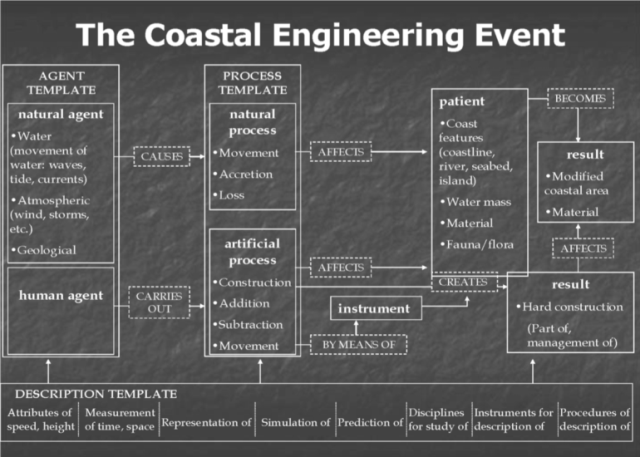
Figure 1 Coastal Engineering Event by FABER (2009)
Accordingly, each sub-domain within the event is characterized by a template with a prototypical set of conceptual relations. This logically places emphasis on terminological definitions, which are regarded as mini-knowledge representations or frames. Such definitions are not entered in a cut-and-paste fashion from other resources. Rather, they result from comparing data through corpus analysis. This is evident in the following description of engine failure. According to FABER’s EE event, we have made a template about the Uncontained Engine Failure Event as in Figure 2.
A turbine engine failure occurs when a turbine engine unexpectedly stops producing power due to a malfunction other than fuel exhaustion. Engine failures may be described either as contained or uncontained. A contained engine failure is one in which components might separate inside the engine, but either remain within the engine cases or exit the engine through the tailpipe. An uncontained engine event occurs when an engine failure results in fragments of rotating engine parts, penetrating and exiting through the engine case. Uncontained turbine engine disk failures within an aircraft engine present a direct hazard to an airplane and its passengers, because high-energy disk fragments can penetrate the cabin or fuel tanks, damage flight control surfaces, set fire to flammable fluid or sever hydraulic lines.
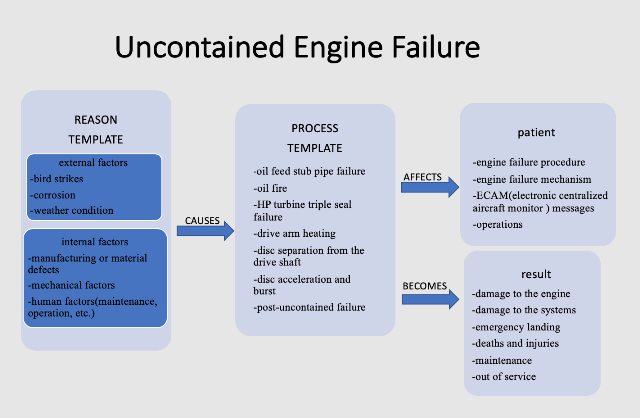
Figure 2 Uncontained Engine Failure Event
Engine failures can be caused by mechanical problems in the engine itself, such as damage to portions of the turbine or oil leaks, as well as damage outside the engine such as fuel pump problems or fuel contamination. A turbine engine failure can also be caused by entirely external factors, such as volcanic ash, bird strikes or weather events such as icing conditions. These risks can sometimes be negated through the use of supplementary ignition or anti-icing systems.
The study of corpus data, i.e. concordances from specialized language texts, offers several attributes relative to engine failure as a process, as well as its relations to other entities in the same domain. These attributes will constitute its definition, map out its conceptual relations, link it to other concepts, and provide information about its combinatory potential in one or various languages. By analyzing concordances, the following information about engine failure, i.e. uncontained engine failure, comes to light:
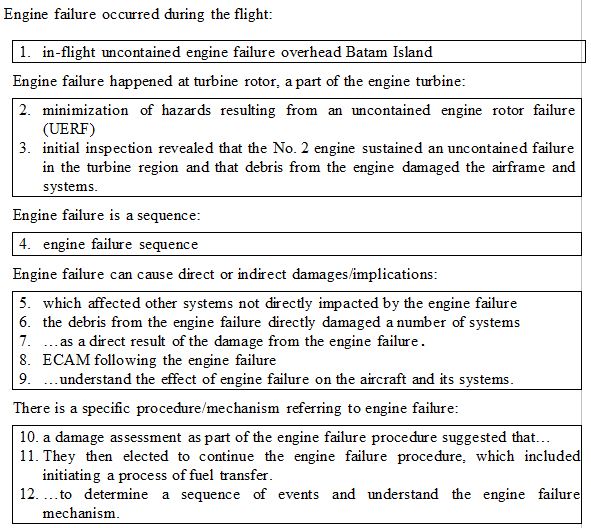
This basic information about engine failure is activated in the context with more specific terms that appear as hyponyms of engine failure in the corpus. These complex nominal forms have their own syntax. A full list of such terms is given below (Table 1).
Table 1: Complex nominal forms
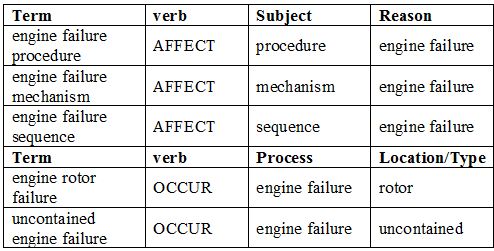
These propositional representations can be activated in different ways, depending on the language involved and its rules for term formation. According to GOLDBERG (1995: 5), the basic clause types of a language form an interrelated network, with semantic structures paired with particular forms in as general a way as possible. This is extremely useful in the analysis of syntax in specialized language texts, and in the specification of definitional templates.
The organization of information encoded in definitions can be structured according to its perceptual salience as well as its relationship to information configurations in the definitions of other related concepts within the same category (FABER, LÓPEZ RODRÍGUEZ & TERCEDOR SÁNCHEZ 2001, FABER 2002). This echoes what MARTIN (1998) argued about frames, as definition models, that offer more consistent, flexible, and complete representations.
4.1.2 Characterizing terms
In 4.1.1, the use of FABER’s bottom-up approach was mentioned, whereas in this section, the top-down approach in terminology translation will be discussed. As FABER argues, a domain sometimes refers to the knowledge area itself and sometimes to the categories of concepts within the specialized field.
Document 9835 (Manual on the Implementation of Language Proficiency Requirements issued by ICAO) offers an inventory of events and related domains which characterize the routine and non-routine work of civil aviation staff. The inventory consists of three parts: (1) events, domains, and sub-domains in aerodrome control, e.g. air-misses, approach delay; (2) events and domains linked to en-route air traffic control, e.g. aircraft breakdown, special flights, weather, and MET (meteorology) problems; and (3) other domains such as ground services and airfield facilities. Once the conceptual network has been established, the translator extracts and classifies the terms in the conceptual network and organizes them in the following table (Table 2):
Table 2: Characterizing terms
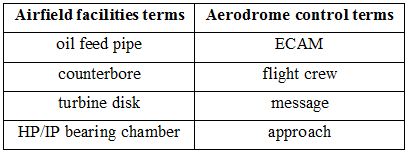
Through the establishment of the conceptual network, the translator developed the necessary background knowledge and classified the main terms. As a descriptive interpretation of the concept, the conceptual network provides a macroscopic understanding of the translation project by relating the concepts and sub-concepts. The terms in Table 2 provides some examples. During the translation process, if an unfamiliar specialized concept arises, the translator can quickly locate it in the conceptual network and determine its relationships with existing concepts. In turn, this helps to establish an appropriate equivalence. In this case, the translator can also compile their own glossary to integrate the existing civil aviation term base.
4.2 Collocating terminological units
Frames also fall within cognitive linguistics approaches; they are a type of cognitive structuring device based on experience that provide the background knowledge and motivation for the existence of words in a language as well as the way those words are used in discourse (FABER 2012: 28). Frames have the advantage of making explicit both the potential semantic and the syntactic behavior of specialized language units. This includes a description of conceptual relations as well as a term combinatorial potential.
As mentioned before, the term engine failure can form a different conceptual unit matching with different verbs, such as engine failure procedure suggested and engine failure directly damaged. Engine failure in both units has the same meaning. However, each context helps the translator identify the proper equivalence of the same term in different units. The following is an example:
The ATSB found that the misalignment of the counterbores was the result of movement within the HP/IP bearing support assembly during manufacture…
澳大利亚运输安全局发现,埋头孔在高压中压承力框架组件中发生位移导致轴心差。
That section of pipe contained an area of reduced wall thickness, which resulted from the misalignment of a counterbore machined into the end of the stub pipe during manufacture.
由于在制造期间短管末端埋头孔未对准轴心,造成该段管道部分管壁较薄。
In general English, misalignment means incorrect arrangement or position of something in relation to something else (Oxford English Dictionary4, sub voce). However, the conceptual unit here is the misalignment of the counterbores/a counterbore. The counterbore in the oil feed stub pipe became misaligned with the axis of the pipe due to movements within the hub structure during the manufacturing process. After the oil feed stub pipe was fitted to the hub, the oil feed stub pipe counterbore was machined using the inner hub counterbore as the reference datum to position the counterbore. Because the inner hub counterbore was misaligned with the axis of the stub pipe, the oil feed stub pipe counterbore was also affected and as a result misaligned with the axis of the stub pipe.
Misalignment is a noun and stems from the verb to misalign. It describes a process, an action through nominalization. The action itself, however, can also be expressed as a definition of a term. The use of misalignments of counterbores in the above passage appear to share the same meaning. In fact, they match with different verbs and as arguments of different verb types, they have different functions. In the first sentence, misalignment occurs with was (i.e. "be" as copula) and is a noun playing the subject function and matching with the verb complement; in the second sentence, misalignment occurs with machined, a transitive verb, and contributes to express an action as an instrument subject. So, for the first misalignment of the counterbores, the translator chooses 轴心差 (zhouxincha, the misalignment between the counterbore and the axis). For the second one, she translates it into 未对准 (weiduizhun, misalign).
4.3 Verifying by images
Another important aspect of Frame-based Terminology is the reliance on images in the form of specialized concepts. For instance, Frame-based Terminology advocates for a multimodal conceptual description in which the context is combined with visual information for a better understanding of complex and dynamic concept systems. In this way, Frame-based Terminology provides a thorough account of the information necessary to fully describe a term.
Traditionally, images have been classified according to their morphology in categories of photographs, drawings, animations, videos, diagrams, charts, graphics, schemes, views, etc. (DARIAN 2001, MONTERDE 2002). However, a more useful way of categorizing images is in terms of their most salient functions (ANGLIN, VAEZ & CUNNINGHAM 2004) or in terms of their relationship with the real-world entity that they represent. Based on that, FABER divides images into three criteria of iconicity, abstraction, and dynamism as ways of referring to specific attributes of specialized concepts. Iconic images resemble the real-world object represented through the abstraction of conceptual attributes in the illustration. Images may have different degrees of resemblance to the object that they represent. Abstraction in an illustration is a matter of degree and refers to the cognitive effort required for the recognition and representation of the concept thus represented (LEVIE & LENTZ 1982, PARK & HOPKINS 1993, RIEBER 1994). Dynamism refers to the representation of movement (i.e. video and animation, as well as images showing different stages of a superordinate process). Dynamic images can be more effective when some complex processes have to be explained. Therefore, illustrations should be chosen provided that they focus on the semantic features activated in the linguistic description of the concept. Their level of iconicity, abstraction, and/or dynamism should be the combination that best portrays the attributes of the concept and the semantic relations they activate (FABER, LEÓN ARAÚZ, VELASCO & REIMERINK 2007: 63). In this respect, few (if any) images are purely iconic, abstract, or dynamic.
These features can be combined to generate eight possible image profiles. As shown in Table 3, the eight possible profiles of graphical information are classifiedaccording to the presence or absence of three main criteria (FABER 2012: 278).
Table 3: Typology of graphical information
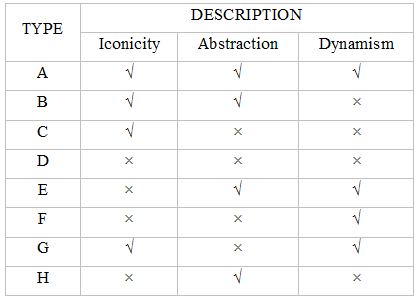
In this translation project, the source text has 15 figures. These figures play an important role in the understanding of concepts as well as in seeking translation equivalents. For some abstract unfamiliar specialized concepts, images provide highly informative visual cues. The following is an example of how the translator verified the meaning of holding by an image:
Example 1: The flight crew contacted ATC and advised that they would need about 30 minutes to process the ECAM messages and associated procedures, and requested an appropriate holding position in order for that to occur. ATC initially cleared the flight crew to conduct a holding pattern to the east of Singapore. Following further discussion amongst the flight crew, ATC was advised that a holding area within 30 NM (56 km) of Changi Airport was required. ATC acknowledged that requirement and directed the aircraft to a different area to the east of the airport and provided heading information to maintain the aircraft in an approximately 20 NM (37 km) long racetrack holding pattern at 7,400 ft.
飞行机组联系空中交通管制并说明他们需要大约30分钟处理电子中央监控信息、执行相关程序,请求空中交通管制提供合适的等待位置。空中交通管制初步批准飞行机组可进入新加坡东部某处等待航线。经飞行机组进一步讨论后,他们告知空中交通管制等待空域需位于樟宜机场30海里(56公里)范围内。空中交通管制明确这一请求,并指引飞机进入另外一个位于机场以东的区域,并提供航向信息确保飞机位于一个长约20海里(37公里)、高7400英尺的等待航线。
After reading the text, the translator can determine the meaning of holding in this context as waiting. However, there are three different units: holding position, holding area, and holding pattern which can be challenging for the translator since position can be regarded as a point, when associated to area as a range, and when collocating with pattern as a shape. Thus, the first need is to identify the differences and similarities concerning holding in the three conceptual units before accurately representing them in the target language.
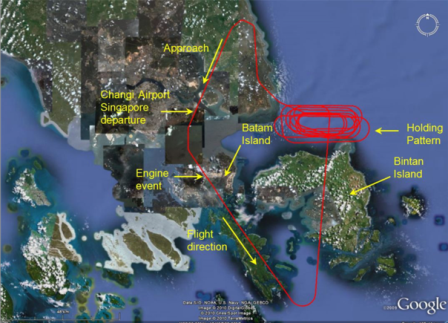
Figure 3: holding pattern (source: Google)
Taken from the source text, the above figure shows the flight route of Qantas 32. On the right hand side of the figure, a yellow arrow points to the position of the holding pattern, while the red lines indicate the dynamic motion of the holding pattern and its tracking scope (which is exactly the holding area, i.e., holding position). According to FABER’s typology of graphical information, Figure 3 belongs to type G, which explicitly shows the dynamism of the specific concept of holding pattern to the reader. With the help of this figure, the translator is able to grasp the meaning by using context-specific information and relying on singular concept units. Thanks to such procedures, Frame-based Terminology offers a full account of the information necessary to understand a term.
Example 2 below is a different typology of graph selected in the source text, representing the meaning of wall thickness:
Example 2: That section of pipe contained an area of reduced wall thickness, which resulted from the misalignment of a counterbore machined into the end of the stub pipe during manufacture. A detailed engineering analysis found that the stresses generated in the oil feed stub pipe were sensitive to the wall thickness, which in turn had a significant effect on the pipe’s fatigue life.
由于在制造期间短管末端埋头孔未对准轴心,造成该段管道部分管壁较薄。一份详细工程分析表明,供油短管中产生的压力对壁厚敏感,反过来又对管道疲劳寿命产生显著影响。
Wall thickness is a term in the field of mechanical manufacturing. In this case, it refers to the dimension between the counterbore and outer surface of the oil feed pipe in the airplane engine. The whole paragraph of the source text attempts to explain the impact of misalignment to the wall thickness, which is a crucial part of this investigative report. Since the translator does not have enough knowledge about aircraft engine manufacturing, painstaking efforts are required to understand such abstract concept and describe it in the target language.
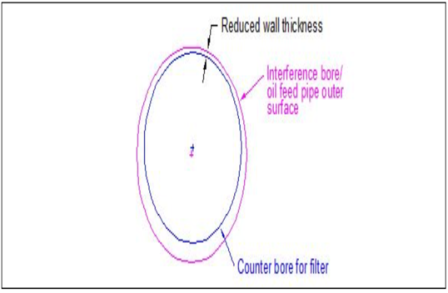
Figure 4: wall thickness
Figure 4 is also selected from the source text. It is a cross-section diagram of the oil feed pipe that was found with cracks. As indicated by the Figure, the blue circle represents the counterbore for the filter while the pink circle represents the interference bore/oil feed pipe outer surface. The blue and pink circles separately show the position of each center axis. According to FABER (2012), this figure is an example of type B. In this figure, we can clearly observe how the misalignment causes reduced wall thickness. The command of this concept resulting from the image paves the way for the translator to understand what follows, such as the cracks in the pipe, the leak of fuel, the explosion of the engine, and eventually, the main reason for the event.
5. Conclusion
Terminology is not only a matter of term entries that try to represent pieces of objective reality. The representation of a specialized field should be more than a list or a configuration of objects linguistically translated into either simple or compound nominal forms. It is necessary to situate concepts in a setting and place them within the context framework of dynamic processes that «define and describe the principal event in the specialized field in question» (FABER, MÁRQUEZ & VEGA 2005: 127). Frame-based Terminology is a new approach to specialized language that focuses on semantic analysis and the meaning of terminological units. The data extracted from multilingual corpora and dictionaries provide the basis for conceptual maps which reflect the place of specialized knowledge units in large knowledge configurations. Concept systems are organized on the basis of definitional templates and situated representations for specialized knowledge concepts. Before flying, student pilots will practice in the flight training simulator to test themselves in a dynamic environment and be confronted with the actual feel of flying operation. Likewise, Frame-based Terminology provides translators with a dynamic context that allows them to fully understand what the terms stand for and their application in context.
This paper has examined the translation of civil aviation terms from English to Chinese under the framework of Frame-based Terminology. It takes a cognitive linguistics approach to develop terminological competence for this domain. The approach is derived from previous studies on Terminology and specialized translation. Likewise, the content is based on a need identified by the first author during a translation experience as an MTI student in China. From establishing a conceptual network, collocating terminological units and verifying them through images, the translator has developed skills and abilities in learning new terms, their use in different strings of text and has organized them in a more precise and systematic way. This is the first time that Frame-based Terminology has been applied to the translation of civil aviation terms. The top-down and bottom-up approaches resulted in this theory becoming a source of insight and inspiration for understanding terms and Language for Specific Purpose (LSP) learning. It is our hope that the study will illuminate how to overcome the challenges within specialized translation, and the complexity of transforming language learners into domain experts.
Acknowledgments
The authors thank Professor Elena Errico from Università di Genova and the reviewers for their comments.
The study was supported by the Postgraduate Education Reform Project (JGLX19_019) Jiangsu Province, China.
References
ALDERSON J. C., «The Politics of Aviation English Testing», Language Assessment Quarterly, n. 8, 4, 2011, pp. 386-403.
ANGLIN G., VAEZ H. & CUNNINGHAM K., «Visual Representations and Learning: the Role of Static and Animated Graphics», in D. JONASSEN (ed.), Handbook of Research on Educational Communications and Technology, Hillsdale, NJ, Lawrence Erlbaum, 2004, pp. 755-794.
BARSALOU L. W., «Situated Simulation in the Human Conceptual System», Language and Cognitive Processes, n. 18, 2003, pp. 513-562.
CABRÉ M. T., «La enseñanza de la terminología en España: problemas y propuestas», Hermèneus, n. 2, 2000, pp. 41-94.
CABRÉ M. T., «Terminology and Translation», in Y. GAMBIER & L. van DOORSLAER (eds.), Handbook of Translation Studies, Amsterdam/Philadelphia, John Benjamins, 2010, w.p.
DARIAN S., «More than Meets the Eye: the Role of Visuals in Science Text-books», LSP & Professional Communication, n. 1, 1, 2001, pp. 10-36.
FABER P., «Terminographic Definition and Concept Representation», in B. MAIA (ed.), Training the Language Services Provider for the New Millennium, Oporto, University of Oporto, 2002, pp. 343-354.
FABER P., «Terminological Competence and Enhanced Knowledge Acquisition», Research in Language, n. 1, 2003, pp. 95-117.
FABER P., «The Cognitive Shift in Terminology and Specialized Translation», MonTI, n. 1, 2009, pp.107-134.
FABER P., «The Dynamics of Specialized Knowledge Representation: Simulational Reconstruction or the Perception-Action Interface», Terminology, n. 17, 1, 2011, pp. 9-29.
FABER P., A Cognitive Linguistics View of Terminology and Specialized Language, Berlin, de Gruyter, 2012.
FABER P. et al., «Process-oriented Terminology Management in the Domain of Coastal Engineering», Terminology, n. 12, 2, 2006, pp. 189-213.
FABER P. & CASTRO M. B., «EcoLexicon», in C. ABEL & N. RALLI (eds.) Proceedings of the XVI EURALEX International Congress, Bolzano, EURALEX, 2014, pp. 601-607.
FABER P., LEÓN ARAÚZ P. & REIMERINK A., «EcoLexicon: New Features and Challenges», in I. KERNERMAN, I. KOSEM TROJINA, S. KREK & L. TRAP-JENSEN (eds.), GLOBALEX 2016: Lexicographic Resources for Human Language Technology in Conjunction with the 10th Edition of the Language Resources and Evaluation Conference, Portorož, 2016, pp. 73-80.
FABER P., LEÓN ARAÚZ P., VELASCO J. & REIMERINK A., «Linking Images and Words: the Description of Specialized Concepts», International Journal of Lexicography, n. 20, 2007, pp. 39-65.
FABER P., LÓPEZ RODRÍGUEZ C. & TERCEDOR SÁNCHEZ M., «Utilización de técnicas de corpus en la representación del conocimiento médico», Terminology, n. 7, 2, 2001, pp. 167-197.
FABER P., MÁRQUEZ C. & VEGA M., «Frame-based Terminology: A Process-oriented Approach», Meta: Translators’ Journal, n. 50, 4, 2005, pp. 121-146.
GOLDBERG A., A Construction Grammar Approach to Argument Structure, Chicago, University of Chicago Press, 1995.
GRINEV S. & KLEPALCHENKO I., «Terminological Approach to Knowledge Representation», in P. SANDRINI (ed.), TKE '99: Proceedings of the 5th International Congress on Terminology and Knowledge Engineering, Innsbruck, Austria, 1999, pp. 147-151.
HUANG D. X. & LI Z. Z., 民航术语的透明翻译 «Transparent translation of civil aviation terminology», 北京航空航天大学学报 (社会科学版) Journal of Beijing University of Aeronautics and Astronautics (Social Sciences Edition), n. 1, 2017, pp. 108-114.
LENG B. B., WANG H. S. & LIANG A. L., 高校MTI术语课程构建 «On the construction of terminology course for MTI students», 中国翻译 Chinese Translators’ Journal, n. 1, 2013, pp. 55-59.
LEÓN ARAÚZ P., MAGAÑA P. & FABER P., «Building the SISE: an Environmental Ontology», in J. HREBICEK et al. (eds.), Proceedings of the EU Conference, Towards Environment, Opportunities of SEIS and SISE: Integrating Environmental Knowledge, Brno, Masaryk University, 2009, w.p.
LEVIE W. H. & LENTZ R., «Effects of Text Illustrations: a Review of Research», Educational Communication and Technology Journal, n. 30, 1982, pp. 195-232.
LIANG A. H., 梁爱林,从术语的属性看中国的术语学教育 «Approaching China’s terminology education from the perspective of the nature of terms », 中国科技术语 China Terminology, n. 4, 2010, pp. 32-36.
MARTIN W., «Frames as Definition Models for Terms», Proceedings of the International Conference on Professional Communication and Knowledge Transfer: Terminology Work and Knowledge Transfer, Vienna, TermNet, 1998, pp.189-221.
MARTÍNEZ S. M. & FABER P., «Terminological Competence in Translation», Terminology, n. 1, 2009, pp. 88-104.
MONTERDE A. M., «Importancia de la ilustración para la traducción técnica: estudio en el campo de la aeronáutica», in C. GONZALO GARCÍA & V. GARCÍA YEBRA (eds.), Manual de documentación, terminología y traducción especializada, Madrid, Arco, 2002, pp. 259-274.
NUNLIST T., «Flying High: China’s Aviation Industry is Becoming a Global Force», CKGSB Knowledge newsletter, http://knowledge.ckgsb.edu.cn/2017/04/17/airline-industry/china-aviation-industry-becoming-global-force/ (last accessed 20/02/2020).
PARK O. & HOPKINS R., «Instructional Conditions for Using Animated Visual Displays: a Review», Instructional Science, n. 22, 1993, pp. 1-24.
PAVEL S. & NOLET D., Précis de terminologie/The Handbook of Terminology, adapted into English by C. LEONHARDT, Hull, Public Works and Government Services of Canada, 2001.
PRANDI M. & ROSSI M., «Introduzione», M. PRANDI, E. PUSILLO, M. ROSSI & J. VISCONTI, Publif@rum, n. 27, 2017, w.p.
REIMERINK A. & FABER P., «EcoLexicon: A Frame-based Knowledge Base for the Environment», in J. HREBICEK et al. (eds.), European conference of the Czech Presidency of the Council of the EU, TOWARDS eENVIRONMENT (Challenges of SEIS and SISE: Integrating Environmental Knowledge in Europe), Brno, Masaryk University, 2009, w.p.
REIMERINK A., LEÓN ARAÚZ P. & FABER P., «A Qualia-based Description of Specialized Knowledge Units in the Lexical-constructional Model», Terminàlia, n. 1, 2010, pp. 17-25.
RIEBER L. P., Computers, Graphics, and Learning, Madison, WI, Brown & Benchmark, 1994.
ROGERS M., «Translating Specialized Texts: from Terms to Communication», Journal of Specialized Translation, n. 18, 2012, pp. 1-6.
SAN MARTÍN A. et al., «Recent Advances in EcoLexicon», Dictionaries: Journal of the Dictionary Society of North America, n. 38, 1, 2017, pp. 96-115.
TEMMERMAN R., «Questioning the Univocity ideal: the Difference between Socio-cognitive Terminology and Traditional Terminology», Hermes, Journal of Linguistics, n. 18, 1997, pp. 51-91.
TEMMERMAN R., Towards new Ways of Terminology Description: the Socio-cognitive Approach, Amsterdam/Philadelphia, John Benjamins, 2000.
TEMMERMAN R., «Socio-cultural Situatedness of Terminology in the Life Sciences: The History of Splicing», in J. ZLATEV, T. ZIEMKE & R. DIRVEN (eds.) Body, Language and Mind, Vol. 2, Interrelations Between Biology, Linguistics and Culture, Berlin, de Gruyter, 2006, w.p.
VELÁSQUEZ G., «Translation and Terminology in Mediated Bilingual Communication», Meta: Translators’ Journal, n. 47, 3, 2002, pp. 444-459.
WANG S. S., 面向翻译的术语能力:理念构成与培养 «Translation-oriented Terminological Competence: Concept, Components and Cultivation», 外语界 Foreign Languages World, n. 5, 2011, pp. 68-75.
ZHOU Q. H., 民航术语规范化探索 «Investigation on Normalization of Chinese Civil Aviation Scientific Terms», 中国科技术语 China Terminology, n. 4, 2010, pp. 41-45, 50.
ZHU B., GAO H., WU H. X. & WANG W., «Studying crashes to avoid clashes: A translational approach to develop terminological competence for aeronautic communication», Círculo de Lingüística Aplicada a la Comunicación, n. 79, 2019, pp. 119-138.
ZHU B. & WANG W., 论民航专业文本中的术语翻译 «On Terminologies in the Domain of Civil Aviation and their Translations», 中国翻译 Chinese Translators Journal, n. 6, 2013, pp. 94-98.
Note
↑ 1 We follow the conventional use of upper case for the theory of Terminology and lower case for terminology as the inventory of terms.
↑ 2 The translator (also the first author) downloaded the full text (about 130,000 words in total) from the official website http://www.atsb.gov.au/publications/investigation_reports.
↑ 3 Additionally, for support, the translator relied on online resources, such as http://www.minhangcidian.com/, http://shuyu.cnki.net/, and Google.
↑ 4 Oxford English Dictionary, online version, https://www.oed.com/ (last accessed 16/05/2020).